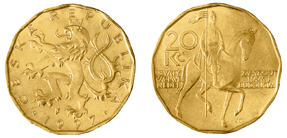Coinage shapes

Although the vast majority of coins are round, coins are made in a variety of other shapes, including, squares, diamonds, hexagons, heptagons, octagons, decagons, and dodecagons. They have also been struck with scalloped (wavy) edges, and with holes in the middle. Coins in the shape of polygons often have rounded edges or are Reuleaux polygons.
This article focuses on circulating coins; a number of non-circulating commemorative coins have been made in special shapes, including guitars, pyramids, and maps.[1]
Squares and diamonds

Indo-Greek coins were often square.
Many countries have struck square coins with rounded corners. Some of these, such as the Netherlands 5 cent coin of World War II and the Bangladesh 5 poisha coin, are oriented as a square, while others, such as the Netherlands Antilles 50 cent and the Jersey 1 pound coin, are oriented as a diamond.
Siege money, such as Klippe coins or the siege money of Newark, was often in the shape of a lozenge.
Pentagonal
The Mutawakkilite Kingdom of Yemen introduced pentagonal 1⁄16 and 1⁄8 rial coins in 1948.
Hexagonal
The Belgian Congo had an hexagonal 2 franc coin, and did the Kingdom of Egypt (2 piastres), and Burma (25 pyas). India used to have 3 paise and 20 paise coins that were hexagonal with rounded corners.
Heptagonal
The Madagascar 10 ariary coin is seven-sided. The British twenty pence and fifty pence coins are heptagonal Reuleaux polygons, as is the United Arab Emirates 50 fils coin, the Barbados one dollar coin, and several coins from Botswana. Reuleaux polygons have constant width, which means the currency detectors in coin-operated machines do not need an extra mechanism to detect shape.[2]

Octagonal
The Chile 50 peso coin is eight-sided, as was the old Malta 25 cent coin, some California gold coins and one of the U.S. Panama–Pacific commemorative 50 dollar coins of 1915.
Nonagonal
The Tuvalu 50 cent coin has nine sides.

Decagonal
Hong Kong had a ten-sided 5 dollar coin from 1976 to 1979, while the Philippines had a ten-sided two peso coin from 1983 to 1990.
Hendecagonal
The old Indian 2-rupee coin was eleven-sided, while the Canadian one dollar coin is an eleven-sided Reuleaux polygon.
Dodecagonal
Many countries have struck twelve-sided coins. Coins currently circulating include the British one pound coin; 50 cent coins from Australia, Fiji, and the Solomon Islands; the Tongan 50 seniti coin; and the Croatian 25 kuna coin.

Tridecagonal
The Czech 20 koruna coin has 13 sides.
Pentadecagonal
The commemorative coin from UAE 5 dirham from 1981 has 15 sides, depicting the 15th Century of Hejira.
.jpg)
Scalloped
Many countries have coins with scalloped (wavy) edges. These usually have twelve bumps (e.g. the Vanuatu 100 vatu, 20 Hong Kong cents), but can have other numbers such as eight (the Swaziland 10 cents, Ang Bagong Lipunan Philippine five centavo coin) or sixteen (the Libya 50 dirhams).
Holed
Often a round coin will have a central hole. In some countries this was to allow them to be strung together,[3] while other reasons include difficulty of counterfeiting and ability for visually impaired people to distinguish them from other coins.[4]
Chinese cash coins had a square hole, while many modern coins have a round hole. Examples include the Japan 5 yen coin and the Denmark 1 krone coin. Previously had the hole for the Philippine five centavo coins in 1995–2017.
See also
References
- ↑ Plautz, Jason (13 May 2013). "11 Unusually Shaped Coins". Mental Floss. Retrieved 1 July 2018.
- ↑ Houston, Kevin (8 July 2011). "Curves of constant width – The 50p story". Retrieved 1 July 2018.
- ↑ "Why Do Some Ancient Coins Have Holes In Them?". Retrieved 3 July 2018.
- ↑ Gordenker, Alice (20 June 2006). "5 yen and 50 yen coins". The Japan Times. Retrieved 3 July 2018.
| Wikimedia Commons has media related to Coins by shape. |
.jpg)